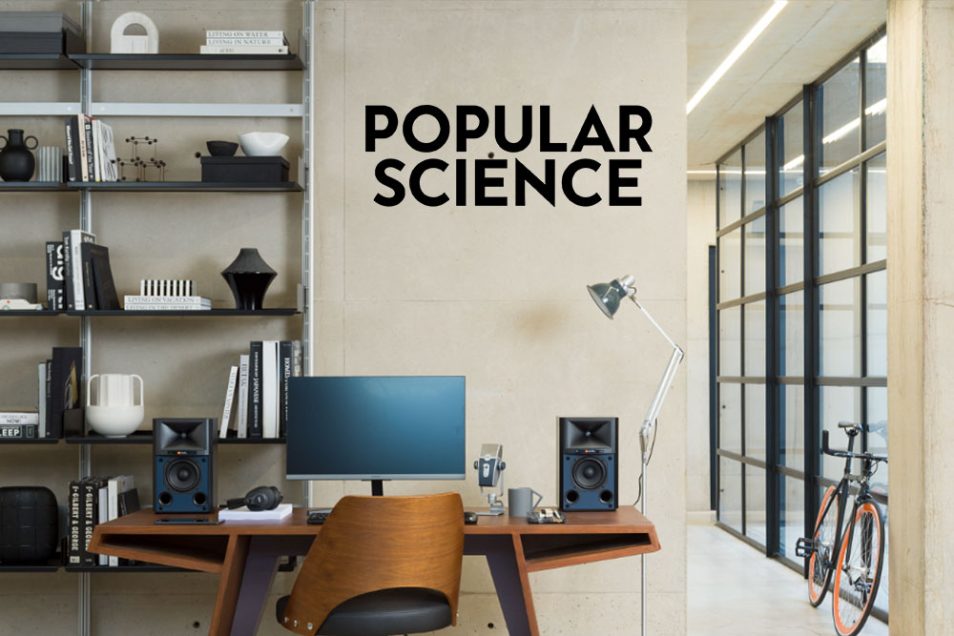From the Audio Files
JBL 4305P Best Overall Powered Speaker in 2023
Popular Science has named the JBL 4305P the Best Overall Powered Speaker of 2023!
JBL's 4305P Studio Monitors - wireless powered speakers with Bluetooth®, Chromecast built-in, and Apple AirPlay® 2 - give you hi-fi sound in a streamlined powered speaker pair. It's a nice reminder of JBL's heritage in the control rooms of many a high-end recording studio.
Formidable power and horn-loaded tweeters
The 4305P's built-in Class D power includes four discrete amplifiers — one for each driver. It sends 25 watts each to the horn-loaded tweeters and 125 watts each to the 5-1/4" woofers. That eliminates the need for passive crossovers and ensures a tailored response for agile, detailed, and muscular sound.
You can use these speakers in your studio for accurate audio reproduction. Or enjoy high-quality home listening with your favorite wireless streaming options. They also include plenty of wired digital and analog inputs.
With their furniture-grade wood veneer finish and retro-styling, they'll look great wherever you place them. And they'll sound great too, since they're front ported and designed for both near- and far-field listening.
Listening impressions of the JBL 4305P Studio Monitors After many years of hearing JBLs in action at concerts in P.A. systems and guitar amps, I know what I love about the JBL sound. When I pulled the 4305P system out of its box for some trial listening, I was hoping to hear some of that.
And they delivered in a bigger way than seems possible from this relatively compact bookshelf speaker system. Paul Desmond's saxophone on “I'm Old Fashioned” from the Pure Desmond album pours like honey out of the speakers' horns. The sound has a lively, spontaneous quality that works really well with the generous drench of plate reverb on Desmond's sax.
They also nicely accentuated that track's mid and bass frequencies, delivering an energetic rendering of the textures and tones of Ed Bickert's guitar and Ron Carter's double-bass. But the low end really came to life on the Bee Gees' “Night Fever.” The 4305P's handling of that track's grandiose verses had a get-up-and-go — and no-joke bass — that took me back to the skating rink circa ‘78.
The relatively modern retro-disco MGMT track “Electric Feel” owes a debt to Bee Gees stuff from that era. But it's got a sweaty-DIY-dance-party edge to it that came through this system in full force. The propulsive mids and lows grab you and pull you into the music, and the synth sparkles get stuck in your hair.
I streamed to the 4305P via Bluetooth, Wi-Fi, and with my Bluesound Node connected to the TRS input. Listening carefully, I could hear the increase in sound quality sequentially across those formats. But the system retained that assertive real-time character, like the next best thing to seeing a band live.
Control in your hands
Front-panel and remote controls let you power on and off, switch sources, control playback, and more. The free MusicLife app for Apple® and Android™ devices gives you another control option.
But with Bluetooth, Roon, Chromecast built-in, and Apple AirPlay 2 all native to the 4305P, you can do pretty much everything from within your smartphone's streaming apps.
Flexible connections and high-res DAC
You can connect the 4305P to your home network via Wi-Fi or Ethernet. Its combination XLR/TRS input lets you add analog sources with a balanced or unbalanced connection. There's also a 3.5mm analog aux input, plus an optical digital connection. An asynchronous USB input lets you connect a computer and enjoy precise sound with your stored digital music files.
The system's built-in DAC supports high-res audio, and with the primary and secondary speakers connected wirelessly, you'll get 24-bit/96kHz resolution. Use the included Digital Link cable to reach the system's maximum resolution of 24-bit/192kHz.
You can connect a powered subwoofer for more oomph in the low frequencies — and more headroom in the 4305P, since it automatically engages an 80Hz high-pass filter.
Link to full review here.

